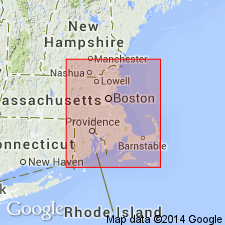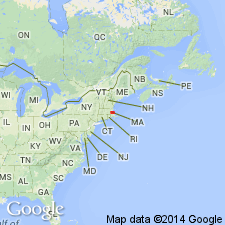
- Usage in publication:
-
- Roxbury Conglomerate*
- Modifications:
-
- Age modified
- AAPG geologic province:
-
- New England province
Summary:
Age of Roxbury Conglomerate changed to Proterozoic Z and possibly Early Cambrian. Boston Bay Group (including Roxbury Conglomerate) has been considered to be Pennsylvanian on the basis of now-discredited plant fossils and by correlation with rocks of Narragansett basin (Billings, 1976). Recent isotopic data of the Mattapan Volcanic Complex and field observations (Kaye and Zartman, 1980) indicate that Boston Bay rocks underlie fossiliferous Cambrian strata; thus the Boston Bay rocks may be as old as Proterozoic Z. In support of Kaye and Zartman's (1980) data, acritarchs of Proterozoic Z to Early Cambrian age have been identified in Cambridge Argillite (Lenk and others, 1982). [Authors state that Bedrock Geologic Map of Massachusetts will show Boston Bay Group rocks as being Proterozoic Z and Paleozoic because it was compiled before the discovery of fossils.]
Source: GNU records (USGS DDS-6; Reston GNULEX).

- Usage in publication:
-
- Roxbury Conglomerate*
- Modifications:
-
- Overview
- AAPG geologic province:
-
- New England province
Summary:
Used as Roxbury Conglomerate of Proterozoic Z to earliest Paleozoic age. Subdivided into a conglomerate, sandstone, siltstone, argillite, and melaphyre unit that includes Brookline, Dorchester, and Squantum Members, and a melaphyre unit where able to map separately.
Source: GNU records (USGS DDS-6; Reston GNULEX).

- Usage in publication:
-
- Roxbury Conglomerate
- Modifications:
-
- Not used
- AAPG geologic province:
-
- New England province
Summary:
Authors state, "...historic stratigraphy and stratigraphic units of the Boston basin are suspect." They suggest that the only formal nomenclature that should be retained is Boston Bay Group, undifferentiated, and perhaps the Weymouth Formation and the Braintree Argillite. Units within the Boston Bay Group--the Cambridge Argillite, and the Brookline, Dorchester, and Squantum (Tillite) Members of the Roxbury Conglomerate--were defined largely on the basis of the percentage of conglomerate, diamictite, argillite, sandstone, siltstone, tuff, and matrix present. Authors believe that recognition of these units in the field is nearly impossible and propose a facies-derived model for the Boston basin. They suggest that the Boston Bay Group was deposited in a submarine fan/slope/apron environment.
Source: GNU records (USGS DDS-6; Reston GNULEX).

- Usage in publication:
-
- Roxbury Conglomerate*
- Modifications:
-
- Overview
- AAPG geologic province:
-
- New England province
Summary:
Roxbury Conglomerate forms base of Boston Bay Group. Divided into Brookline, Dorchester, and Squantum Members. Conglomerate in Brookline Member contains clasts of Dedham Granite, quartzite (possibly from Westboro Formation), and volcanic rock from underlying Mattapan Volcanic Complex. Dorchester Member consists of interbedded argillite and sandstone and forms an intermediate unit between Brookline Member and overlying Cambridge Argillite. Uppermost Squantum Member is a distinctive diamictite which appears to pinch out in northern part of basin. Brighton Melaphyre lies within Brookline Member and consists of mafic volcanic rocks (quartz keratophyre, keratophyre, and spilite). Roxbury clearly lies nonconformably on Dedham Granite near Hull, MA; can be traced continuously over Mattapan Volcanic Complex. Age is Proterozoic Z and possibly Early Cambrian. Report contains geologic maps and correlation charts. [Chapters A-J in U.S. Geological Survey Professional Paper 1366 are intended as explanations and (or) revisions to 1:250,000-scale MA State bedrock geologic map of Zen and others (1983).]
Source: GNU records (USGS DDS-6; Reston GNULEX).
For more information, please contact Nancy Stamm, Geologic Names Committee Secretary.
Asterisk (*) indicates published by U.S. Geological Survey authors.
"No current usage" (†) implies that a name has been abandoned or has fallen into disuse. Former usage and, if known, replacement name given in parentheses ( ).
Slash (/) indicates name conflicts with nomenclatural guidelines (CSN, 1933; ACSN, 1961, 1970; NACSN, 1983, 2005, 2021). May be explained within brackets ([ ]).

